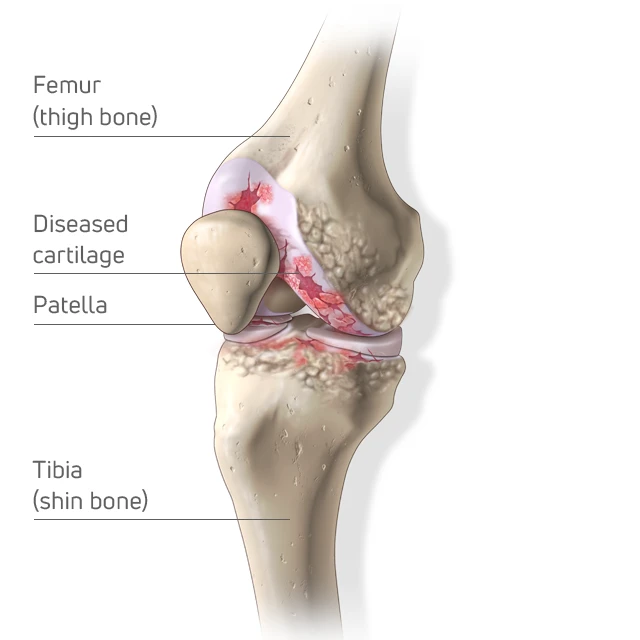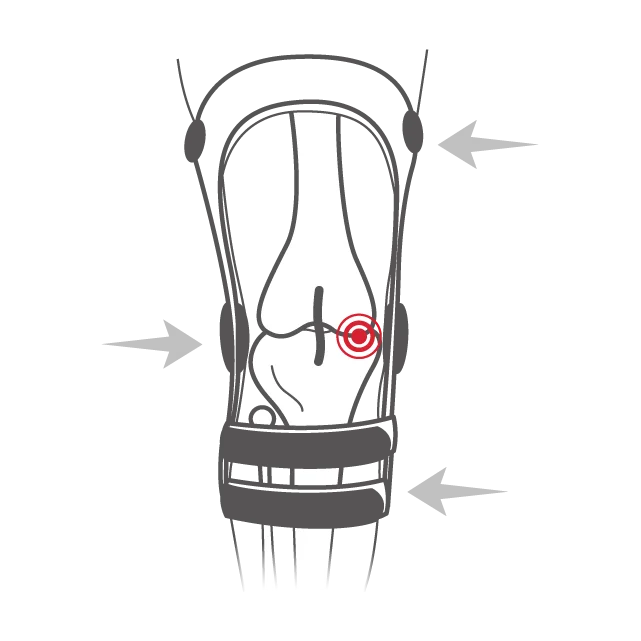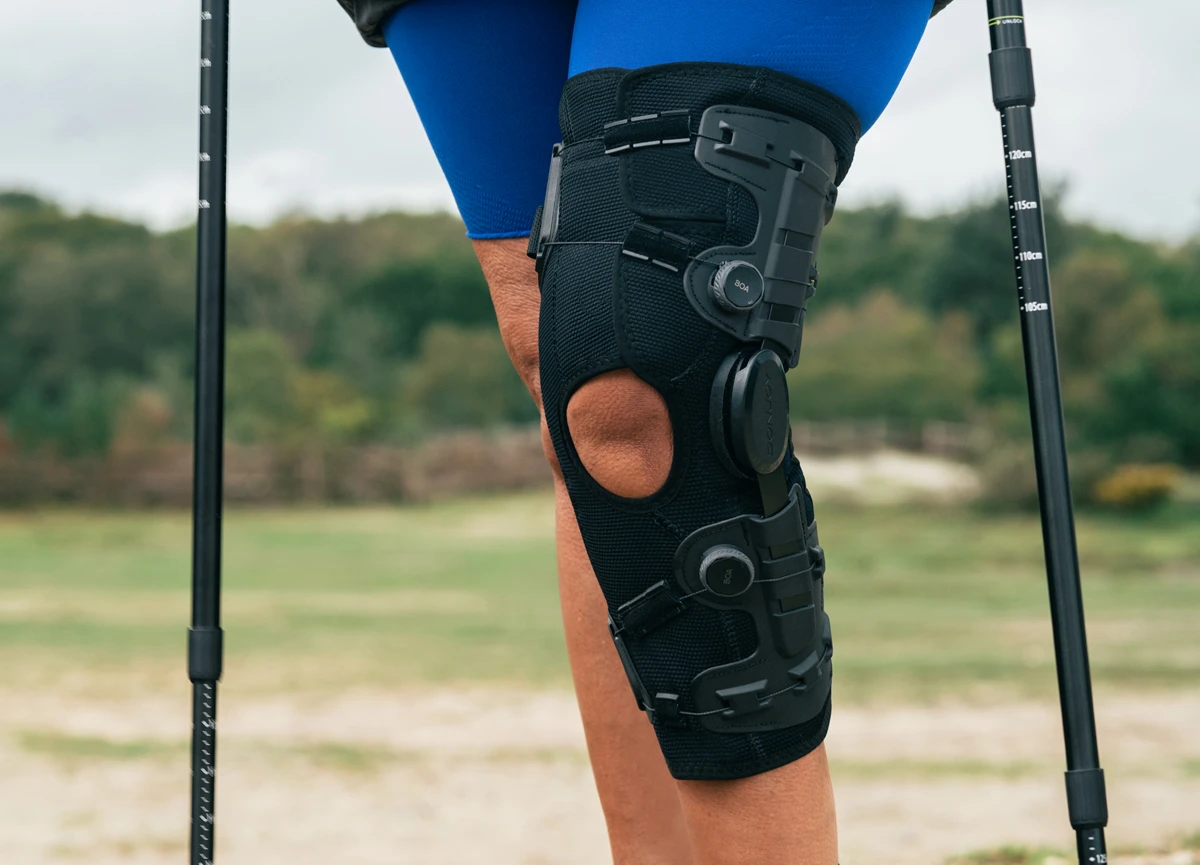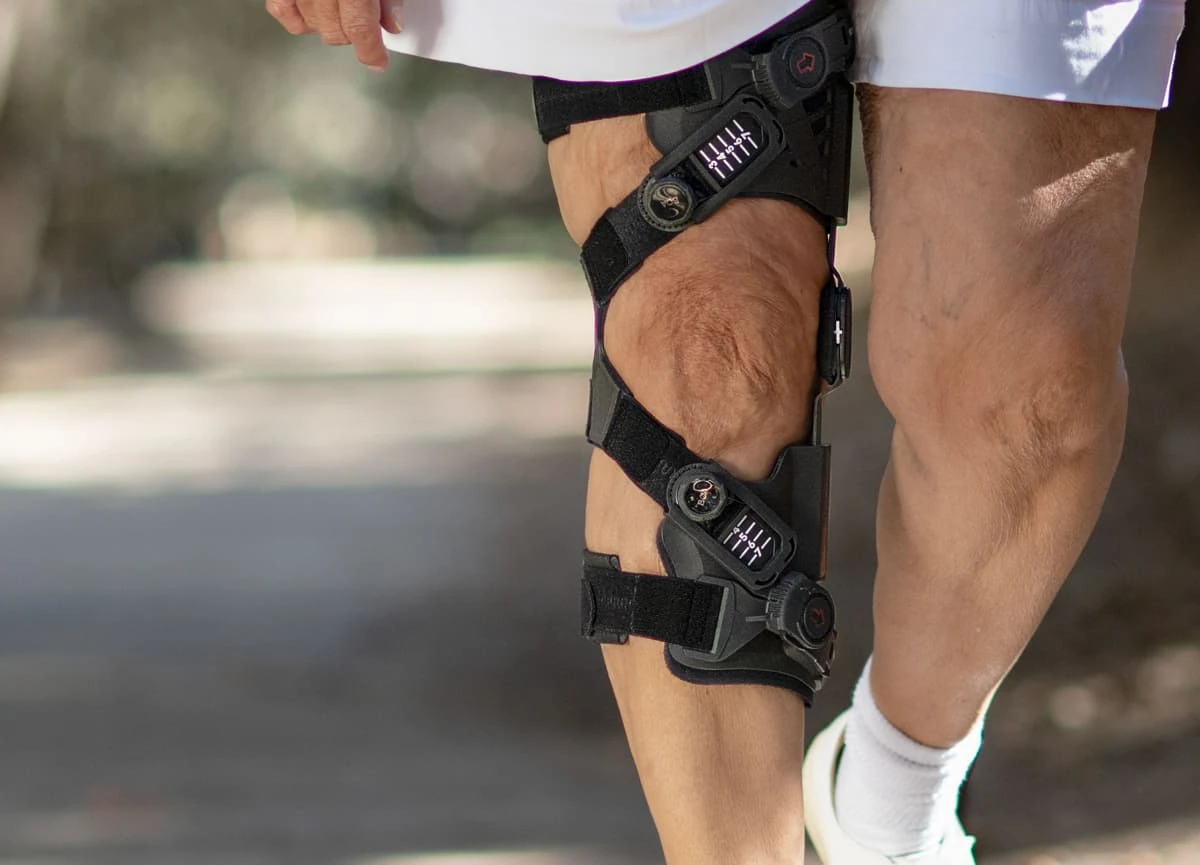Patient Education
What is knee osteoarthritis?

The most common type of arthritis is osteoarthritis, also known as OA or degenerative joint disease (DJD).
Knee osteoarthritis occurs when the rubbery cartilage that covers the ends of your leg bones breaks down. This cartilage provides a cushion between the bones, allowing them to glide smoothly over each other, but when it deteriorates the bones begin to rub together. The resulting friction can not only make the knee painful, but also swollen and stiff, and the joint may feel locked or weak.
The exact cause of knee osteoarthritis is unknown, but contributing factors may include previous injury, aging, misalignment, genetics, and obesity. Osteoarthritis is a degenerative disease that usually progresses slowly as you get older.
Along with information about our latest knee OA brace products, here you can find facts and guidance to help manage knee OA and maintain an active and healthy lifestyle.
The symptoms of knee osteoarthritis
PAIN
Knee pain may progress from mild soreness and aching with movement to severe pain even during rest. OA can cause pain in several ways, including
- Irritation and pressure on the nerve endings of the bones
- Inflammation of the joint lining (synovitis)
- Muscle tension and fatigue
LOSS OF MOVEMENT
As the cartilage between bones wears away, the joint no longer glides smoothly. Eventually, the ends of the bones become rough and irregular, causing stiffness and lack of mobility. As a result, the muscles around the knee weaken, making movement difficult. The joint may feel locked or it may give way easily.
GRINDING AND “POPPING” SENSATIONS
Loss of knee cartilage leads to friction in the joint that can cause these uncomfortable sensations.
SWELLING
OA causes inflammation, which can lead to swelling and feelings of warmth around the joint.
Your doctor will typically determine whether you have OA based on your symptoms, medical history, a physical exam, and knee X-rays. An MRI may be helpful in some cases to confirm the diagnosis and rule out other conditions.
Managing knee osteoarthritis
OA pain often causes a person to become less active. In addition to weight gain, decreased activity can cause muscle weakness, which may lead to increased joint pain. Being unable to do your favorite activities can also leave you feeling frustrated and depressed.
While there is no cure for osteoarthritis, several treatments can help decrease pain and swelling, improve joint motion and muscle strength, and make it easier to perform everyday activities.
- Exercise such as walking, strength training, swimming, biking, yoga, tai chi, and other low-impact activities may help with pain and function of the knee
- Bracing can help stabilize the joint, reduce pain1, and build stronger muscles
- Pain-relief devices such as TENS units can help alleviate OA pain without the use of opioids2
- Medications such as paracetamol, non-steroidal anti-inflammatory drugs (NSAIDs), topical NSAIDs, prescription medications, and corticosteroid or hyaluronic acid injections can help relieve OA knee pain3
- In some cases, surgery may be recommended to repair or replace the damaged joint
1. Brophy RH, Fillingham YA. AAOS Clinical Practice Guideline Summary: Management of Osteoarthritis of the Knee (Nonarthroplasty), Third Edition. J Am Acad Orthop Surg. 2022 May 1;30(9):e721-e729.
2. American Academy of Orthopaedic Surgeons Management of Osteoarthritis of the Knee (Non- Arthroplasty) Evidence-Based Clinical Practice Guideline. https://www.aaos.org/oak3cpg Published 08/31/2021.
3. Osteoarthritis in over 16s: diagnosis and management. NICE 2022 guidelines. https://www.nice.org.uk/guidance/ng226 Published 19/10/2022.
Exercises for knee osteoarthritis
Studies show that a continuous and sustainable training process is essential to strengthening the structures in the knee4. Below is a series of basic exercises that you can do in different variations over a whole year.
How many different exercises does my knee program include?
After an initial phase, the exercise plan consists of six different training exercises. These cover mobility, strengthening, depth perception, and coordination. The level of intensity of these exercises increases gradually every two months.
- Cycling
- Squats
- Balancing
- Skiers
- Lunges (from Month 7)
- Knee presses (from Month 7)
Equipment needed for training
- Chair
- Table
- Elastic training band
- Large towel
How often should I do the exercises?
To achieve the best results, carry out the exercises independently 3 times a week for 12 months, each lasting 30 minutes.
Note: Consult your doctor before starting the exercise program.
4. Brosseau L et al. The Ottawa panel clinical practice guidelines for the management of knee osteoarthritis. Part three: aerobic exercise programs. Clinical rehabilitation, 2017;31(5):612–624.
Introductory exercises (Week 1-2)
Level 1 exercises (Month 1-2)
Level 2 exercises (Month 3-4)
Level 3 exercises (Month 5-6)
Supplemental exercises (Month 7-8)
Supplemental exercises (Month 9-10)
Supplemental exercises (Month 11-12)
Bracing for knee osteoarthritis
5. Brophy RH, Fillingham YA. AAOS Clinical Practice Guideline Summary: Management of Osteoarthritis of the Knee (Nonarthroplasty), Third Edition. J Am Acad Orthop Surg. 2022 May 1;30(9):e721-e729.
6. Dries T, Van Der Windt JW, Akkerman W, Kluijtmans M, Janssen RPA. Effects Of A Semi-rigid Knee Brace On Mobility And Pain In People With Knee Osteoarthritis. J Rehabil Med Clin Commun. 2022 Jul 5;5:2483.
7. Khan SJ, Khan SS, Usman J, Mokhtar AH, Abu Osman NA. Orthoses versus gait retraining: Immediate response in improving physical performance measures in healthy and medial knee osteoarthritic adults. Proc Inst Mech Eng H. 2020 Jul;234(7):749-757.
8. Alfatafta H, Onchonga D, Alfatafta M, Zhang L, Boncz I, Lohner S, Molics B. Effect of using knee valgus brace on pain and activity level over different time intervals among patients with medial knee OA: systematic review. BMC Musculoskelet Disord. 2021 Aug 12;22(1):687.
9. Nagai K, Yang S, Fu FH, Anderst W. Unloader knee brace increases medial compartment joint space during gait in knee osteoarthritis patients. Knee Surg Sports Traumatol Arthrosc. 2019 Jul;27(7):2354-2360.
10. Dessinger GM, LaCour MT, Dennis DA, Kleeman-Forsthuber LT, Komistek RD. Can an OA Knee Brace Effectively Offload the Medial Condyle? An In Vivo Fluoroscopic Study. The Journal of arthroplasty. 2021 36(4), 1455–1461.
3-POINT OFF-LOADING
We mechanically shift weight away from the damaged part of the knee to help address four common relief points for those suffering from OA. Every DonJoy® OA knee brace can off-load either the medial or lateral compartment and incorporate load-adjustment mechanisms that allow patients to fine tune their brace to meet their daily needs.


